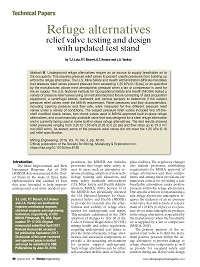Mining Publication: Refuge Alternatives Relief Valve Testing and Design with Updated Test Stand
Original creation date: March 2018
Authors: T Lutz, P Bissert, G Homce, J Yonkey
Underground refuge alternatives require an air source to supply breathable air to the occupants. This requires pressure relief valves to prevent unsafe pressures from building up within the refuge alternative. The U.S. Mine Safety and Health Administration (MSHA) mandates that pressure relief valves prevent pressure from exceeding 1.25 kPa (0.18 psi), or as specified by the manufacturer, above mine atmospheric pressure when a fan or compressor is used for the air supply. The U.S. National Institute for Occupational Safety and Health (NIOSH) tested a variety of pressure relief valves using an instrumented test fixture consisting of data acquisition equipment, a centrifugal blower, ductwork and various sensors to determine if the subject pressure relief valves meet the MSHA requirement. Relief pressures and flow characteristics, including opening pressure and flow rate, were measured for five different pressure relief valves under a variety of conditions. The subject pressure relief valves included two off-Theshelf modified check valves, two check valves used in MSHA-Approved built-in-place refuge alternatives, and a commercially available valve that was designed for a steel refuge alternative and is currently being used in some built-in-place refuge alternatives. The test results showed relief pressures ranging from 0.20 to 1.53 kPa (0.03 to 0.22 psi) and flow rates up to 19.3 m3/ min (683 scfm). As tested, some of the pressure relief valves did not meet the 1.25 kPa (0.18 psi) relief specification.

- Disaster Survivability for Refuge Alternative Relief Valves
- Emergency Escape and Refuge Alternatives
- Evaluation and Testing of Pressure Relief Valves (PRVs) for Refuge Alternatives Subjected to Explosive Forces
- How to Operate a Refuge Chamber: A Quick Start Guide
- Recommendations for Refuge Chamber Operations Training
- Refuge Alternatives in Underground Coal Mines
- Technology News 537 - NIOSH Develops New Mine Refuge Chamber Training
- Underground Mine Refuge Chamber Expectations Training: Program Development and Evaluation
- When Do You Take Refuge? Decisionmaking During Mine Emergency Escape
- Work-Principle Model for Predicting Toxic Fumes of Nonideal Explosives